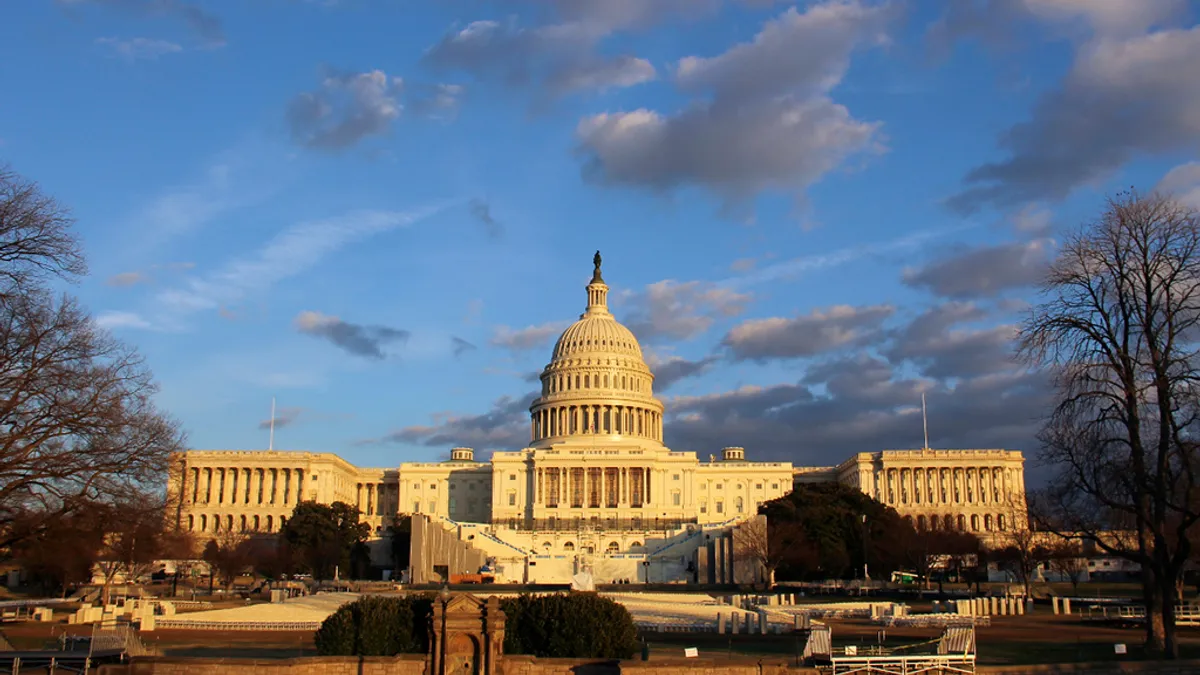Dive Brief:
- Rep. Mike Doyle, D-Pa., on Thursday introduced legislation long awaited by clean energy advocates: a tax credit for energy storage technologies.
- H.R. 2096 aims to make energy storage technologies fully eligible for the investment tax credit (ITC) that is currently available to solar and some solar-plus-storage projects. The solar ITC is set to phase down from 30% in 2019 to 26% for projects that start in 2020, 22% in 2021 and 10% for all commercial and utility projects that start thereafter.
- More than 100 House Democrats signed a letter to Ways and Means Committee Chair Richard Neal, D-Mass., on Thursday, asking for a long-term extension of clean energy tax credits, including storage, alternative-fuel vehicles and energy efficiency-based provisions. The request follows efforts by the Trump administration to "undermine" the Environmental Protection Agency's Clean Power Plan, according to the letter.
Dive Insight:
While the Green New Deal is getting a lot of attention, Congressional Democrats are also pushing specific, near-term steps to address the challenges of climate change.
On Thursday, House Democrats introduced legislation to increase deployments of clean energy technologies like energy storage. Over 100 Democrats also asked for clean energy tax policies to be added to any upcoming broader tax legislation or infrastructure package.
"We are cognizant that Congress last extended many of these clean-energy tax credits with the understanding that they would eventually begin to be phased out," the letter said, noting that the ITCs and other tax credits were meant "to serve as a bridge for the implementation of the EPA's Clean Power Plan" to reduce emissions from coal-fired power plants and other carbon emissions reduction policies.
"This is no longer the case. The Trump Administration’s efforts to undermine the CPP and other commonsense safeguards for new and existing power plants, relax fuel economy standards for cars and trucks, curtail potent methane emissions, and withdraw the United States from the Paris Climate Accords have fundamentally altered the framework by which the 2015 agreement was reached," the letter states.
Among the signatories is Rep. Paul Tonko, D-N.Y., who introduced a bill to challenge the president's 2017 decision to pull the United States out of the Paris accord.
The letter suggests policies to encourage greater adoption of alternative fuel vehicles along with incentives to build out charging/fueling infrastructure for electric and alternative vehicles, and performance-based tax incentives for energy efficiency in new and existing buildings. It also recommends incentives to reduce industrial emissions, and continued wind and solar incentives, including additional incentives for "nascent technologies, such as offshore wind."
The letter also emphasizes the efforts from H.R. 2096, asking Ways and Means leadership to "clarify the tax code for energy storage technologies, which are critical for the continued deployment and expansion of intermittent, clean energy technologies, such as wind and solar, and help modernizing the electric grid to make it more efficient and resilient."
In 2017, Doyle introduced a bipartisan bill to create a separate energy storage infrastructure ITC based on the existing tax credits for solar energy. This followed a similar effort on the Senate side, introduced in 2016 by Sen. Martin Heinrich, D-N.M., and former Sen. Dean Heller, R-Nev. Energy storage advocates expect a Senate version of the bill to be introduced during this Congress as well.
The credit, which would be technology-agnostic, could further the investment and deployment in non-lithirum-ion batteries, according to the American Council on Renewable Energy (ACORE). Battery storage can be paired with generation, including wind, solar and gas to create a more efficient grid, according to Greg Wetstone, president and CEO of the ACORE.
"For all the talk about resilience, this is the way to get there," Wetstone told Utility Dive.
If the storage tax credit is approved, project developers could start initial investment in a storage project and complete it within four years to qualify for the credit. Meanwhile, the interconnection queue for renewables and storage projects continues to grow and the U.S. grid is badly in need of more transmission infrastructure to add new capacity from clean energy developments.
"Transmission is going to be critical to any of these ambitious proposals to get dramatic reductions in greenhouse emissions," Wetstone said.














